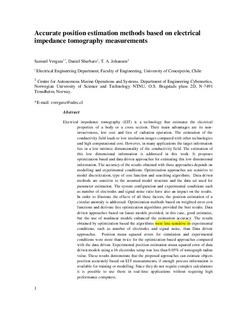| dc.contributor.author | Vergara, Samuel | |
| dc.contributor.author | Sbarbaro, Daniel | |
| dc.contributor.author | Johansen, Tor Arne | |
| dc.date.accessioned | 2017-12-12T14:29:15Z | |
| dc.date.available | 2017-12-12T14:29:15Z | |
| dc.date.created | 2017-10-12T13:42:31Z | |
| dc.date.issued | 2017 | |
| dc.identifier.issn | 0957-0233 | |
| dc.identifier.uri | http://hdl.handle.net/11250/2470869 | |
| dc.description.abstract | Electrical impedance tomography (EIT) is a technology that estimates the electrical properties of a body or a cross section. Its main advantages are its non-invasiveness, low cost and operation free of radiation. The estimation of the conductivity field leads to low resolution images compared with other technologies, and high computational cost. However, in many applications the target information lies in a low intrinsic dimensionality of the conductivity field. The estimation of this low-dimensional information is addressed in this work. It proposes optimization-based and data-driven approaches for estimating this low-dimensional information. The accuracy of the results obtained with these approaches depends on modelling and experimental conditions. Optimization approaches are sensitive to model discretization, type of cost function and searching algorithms. Data-driven methods are sensitive to the assumed model structure and the data set used for parameter estimation. The system configuration and experimental conditions, such as number of electrodes and signal-to-noise ratio (SNR), also have an impact on the results. In order to illustrate the effects of all these factors, the position estimation of a circular anomaly is addressed. Optimization methods based on weighted error cost functions and derivate-free optimization algorithms provided the best results. Data-driven approaches based on linear models provided, in this case, good estimates, but the use of nonlinear models enhanced the estimation accuracy. The results obtained by optimization-based algorithms were less sensitive to experimental conditions, such as number of electrodes and SNR, than data-driven approaches. Position estimation mean squared errors for simulation and experimental conditions were more than twice for the optimization-based approaches compared with the data-driven ones. The experimental position estimation mean squared error of the data-driven models using a 16-electrode setup was less than 0.05% of the tomograph radius value. These results demonstrate that the proposed approaches can estimate an object's position accurately based on EIT measurements if enough process information is available for training or modelling. Since they do not require complex calculations it is possible to use them in real-time applications without requiring high-performance computers. | nb_NO |
| dc.language.iso | eng | nb_NO |
| dc.publisher | IOP Publishing | nb_NO |
| dc.title | Accurate position estimation methods based on electrical impedance tomography measurements | nb_NO |
| dc.type | Journal article | nb_NO |
| dc.type | Peer reviewed | nb_NO |
| dc.description.version | acceptedVersion | nb_NO |
| dc.source.volume | 28 | nb_NO |
| dc.source.journal | Measurement science and technology | nb_NO |
| dc.source.issue | 8 | nb_NO |
| dc.identifier.doi | 10.1088/1361-6501/aa743f | |
| dc.identifier.cristin | 1504165 | |
| dc.relation.project | Norges forskningsråd: 223254 | nb_NO |
| dc.description.localcode | This is an author-created, un-copyedited version of an article accepted for publication/published in [Measurement science and technology]. Locked until 17.7.2018 due to copyright restrictions. IOP Publishing Ltd is not responsible for any errors or omissions in this version of the manuscript or any version derived from it. The Version of Record is available online at http://iopscience.iop.org/article/10.1088/1361-6501/aa743f/meta | nb_NO |
| cristin.unitcode | 194,63,25,0 | |
| cristin.unitname | Institutt for teknisk kybernetikk | |
| cristin.ispublished | true | |
| cristin.fulltext | postprint | |
| cristin.qualitycode | 1 | |
